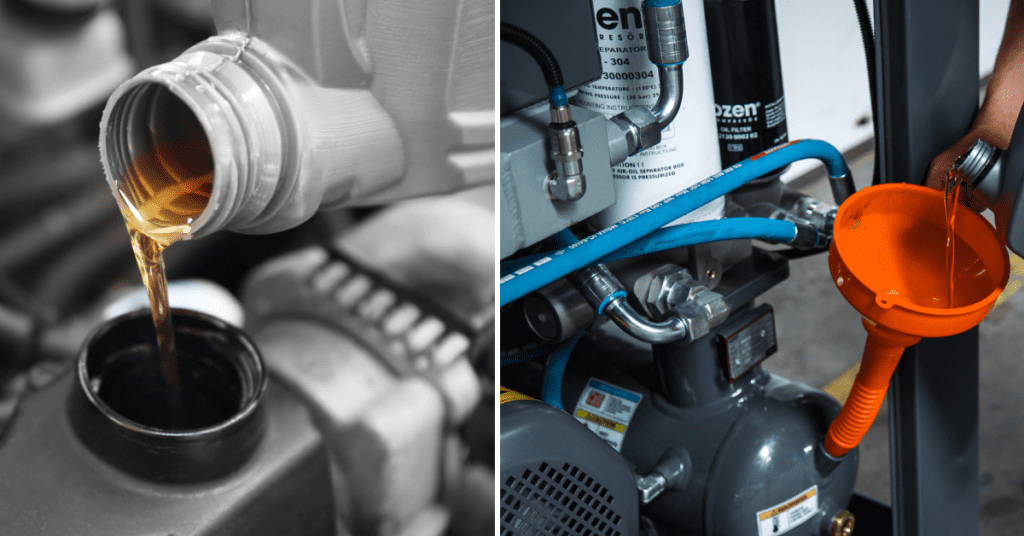How to Change Air Compressor Oil
Are you looking for an easy way to keep your air compressor running smoothly? Keeping your air compressor’s oil changed regularly is one of the most important things you can do to ensure that it runs efficiently and lasts a long time. Changing the oil in an air compressor isn’t difficult or expensive, but neglecting to do so will cause damage over time. In this article, we’ll provide detailed steps on how to change air compressor oil with a fresh new one in just a few simple steps! Let’s jump right in and see what needs to be done so that you can keep your air compressor functioning at peak levels.

Importance of Changing Air Compressor Oil
Regularly changing the oil in your air compressor is crucial for maintaining its performance and longevity. Over time, contaminants such as dirt, dust, and moisture can build up in the oil, making it less effective in lubricating the compressor’s moving parts. This can lead to increased wear and tear on these components, causing them to break down sooner than expected.
Moreover, old oil can also result in a decrease in the compressor’s efficiency. It can cause increased friction, which results in higher temperatures and more strain on the motor. This not only reduces the air compressor’s overall lifespan but also increases energy consumption, leading to higher electricity bills.
Tools and Materials Needed for Changing Air Compressor Oil
Before you start the process of changing your air compressor’s oil, make sure you have all the necessary tools and materials ready. Here is a list of items you’ll need:
- Fresh oil compatible with your air compressor
- A clean container to drain the old oil into
- An adjustable wrench or socket set
- A funnel for pouring in the new oil
- Oil filter (if applicable)
- A rag or paper towels for cleaning any spills or mess
Some air compressors may require additional tools and materials, so it’s always a good idea to consult your user manual beforehand.
Safety Precautions for Changing Air Compressor Oil
Safety should always be a top priority when working with machinery and changing air compressor oil is no exception. Here are some safety precautions to keep in mind before you start:
- Make sure the air compressor is turned off and unplugged from the power source.
- Allow the compressor to cool down before beginning the process.
- Wear protective gear such as gloves and safety glasses to prevent any contact with the oil or other components.
- Place a mat or towel underneath the compressor to catch any spills.
- Follow the manufacturer’s instructions and recommendations for changing the oil.
Identifying the Right Oil for Your Compressor
When it comes to choosing the right oil for your air compressor, there are a variety of options in the market. It’s crucial to select an oil that is compatible with your specific model and meets the manufacturer’s recommendations. Using the wrong type of oil can damage your air compressor and void its warranty.
Not all oils are created equal, and it’s essential to use the correct type of oil for your specific air compressor model. Typically, air compressors require a non-detergent mineral or synthetic-based oil with a viscosity rating between 30-60. Check your user manual or contact the manufacturer for specific oil recommendations.
6 Easy Step-by-Step Guide to Changing Air Compressor Oil
Now that you have all the necessary tools, materials, and safety precautions in place, let’s dive into the step-by-step process of changing your air compressor oil:
Step 1: Preparing the Compressor
Before you begin, it’s important to take a few necessary steps to properly prepare the air compressor for maintenance. Start by ensuring that the compressor is completely turned off and safely disconnected from the power source. This will prevent any accidental start-ups or electrical hazards during the process.
Next, carefully remove any connections, such as hoses or attachments, that are currently attached to the compressor. This will help prevent any obstructions or interference while you work on it. By taking these extra precautions, you’ll ensure a smooth and hassle-free maintenance experience.
Step 2: Draining the Old Oil
To start the oil-changing process, it’s important to place a suitable container or pan underneath the oil drain valve. This will ensure that you catch all the old oil and prevent any mess. Once the container is in place, proceed to remove the oil fill cap and carefully unscrew the drain valve using either an adjustable wrench or a socket set. Take your time to ensure that all the old oil drains out completely before moving on to the next step. This thorough oil-draining process will help maintain the health and longevity of your vehicle’s engine.
Step 3: Replacing the Oil Filter (if applicable)
If your air compressor has an oil filter, it is recommended to replace it during regular maintenance. To do so, start by unscrewing the old oil filter and disposing of it properly. Take care to avoid any spills or leaks. Next, take a new filter and securely screw it in place using your hands. This simple step will help ensure the optimal performance and longevity of your air compressor.
Step 4: Refilling with New Oil
Once all the old oil has completely drained from the compressor, carefully screw the drain valve back into place ensuring a tight seal. Then, gently remove the container used to collect the drained oil. Next, take a clean funnel and position it securely over the compressor’s oil fill hole. With precision, start pouring in the recommended amount of new oil into the funnel, allowing it to smoothly flow down into the compressor’s reservoir.
Step 5: Checking Oil Levels
After carefully filling the compressor with fresh, high-quality oil, make sure to securely replace the oil fill cap. Take a moment to wipe away any oil spills or mess, ensuring a clean and safe working environment. Allow the compressor to sit for a few minutes, allowing the oil to settle and distribute evenly. Then, using the provided dipstick or sight glass, check the oil level to ensure it falls within the recommended range for optimal performance and longevity of the compressor.
Step 6: Testing the Compressor
Once you have completed all the necessary steps, it is time to plug in the air compressor and turn it on to test its functionality. Ensure that all connections are secure and in place. Listen for any unusual noises or vibrations that may indicate a potential issue. Observe the pressure gauge to confirm that the compressor is generating the desired air pressure. If everything looks good and the compressor is operating smoothly, you’re good to go! However, if you notice any leaks or other problems, take a moment to double-check all connections, fittings, and valves. Address any issues promptly to ensure optimal performance and safety.
Proper Disposal of Old Oil
Properly disposing of the old oil is of utmost importance when it comes to safeguarding the environment. It is crucial to avoid pouring used oil down the drain or disposing of it in a regular trash can, as this can lead to contamination of water sources and pose a serious threat to wildlife. To ensure responsible disposal, it is highly recommended to take the used oil to a local recycling center or an auto supply store that offers safe and eco-friendly disposal methods. By doing so, we can actively contribute to the preservation of our natural resources and the well-being of our ecosystem. Let’s make a positive impact together!
Troubleshooting Common Issues When Changing Oil for Air Compressors
Even with proper maintenance, you may encounter some issues while changing your air compressor oil. Here are some common problems and ways to troubleshoot them:
- Oil leaks: If there is an oil leak, check for any loose connections or damaged gaskets and replace them if needed.
- Milky or cloudy oil: This can be a sign of water contamination in the oil. Drain and replace the oil immediately.
- Excessive oil consumption: If your compressor is consuming more oil than usual, it could indicate a potential issue with the valves or piston rings. It’s best to consult a professional for further diagnosis and repair.
Regular Maintenance Tips for Your Air Compressor
To ensure your air compressor continues to run smoothly, it’s essential to perform regular maintenance and check-ups. Here are some tips you can follow:
- Check the oil level regularly and change it according to the manufacturer’s recommendations.
- Clean or replace the air filter as needed to maintain proper airflow.
- Inspect and tighten any loose connections or fittings before using the compressor.
- Keep the compressor clean and free of debris, especially around the motor and vents.
FAQs for Changing Oil in Air Compressors
How often should I change the oil in my air compressor?
The frequency of oil changes varies depending on factors such as usage and type of oil. It is best to refer to the manufacturer’s recommendations for specific instructions.
Can I use regular oil in my air compressor?
No, it is important to use high-quality, non-detergent air compressor oil specifically designed for this purpose. Regular motor oils can cause damage and reduce the lifespan of your compressor.
Can I use hydraulic oil in the compressor?
No, it is not recommended to use hydraulic oil in an air compressor as they are designed for different purposes and have different viscosity levels. Always use the type of oil specified by the manufacturer for optimal performance and longevity of your compressor.
Can I use diesel oil in a compressor?
No, it is not recommended to use diesel oil in a compressor. Compressors require a specific type of oil that is designed to handle the high pressures and temperatures generated by the compressor. Diesel oil is not formulated to handle these conditions and can result in poor performance, increased wear and tear on the compressor, and potential damage to the equipment. It is important to always use the recommended type of oil for your compressor to ensure optimal performance and longevity.
Conclusion
In conclusion, changing the air compressor oil is a simple yet essential part of regular maintenance for any compressor owner. It is important to familiarize oneself with safety precautions and have the right tools and materials before starting the job. Knowing your compressor’s specific needs can help you identify the type and grade of oil that works best. Following detailed steps to properly change the air compressor oil will ensure optimal performance and a longer lifespan.
Lastly, proper disposal of old oil is always required for environmental safety reasons. To guarantee your compressor stays healthy and long-lasting, it is vital to change the air compressor oil often. As always, regular maintenance and troubleshooting of any issues that may arise are necessary to keep your compressor running smoothly.






